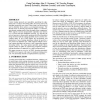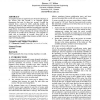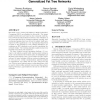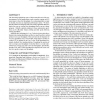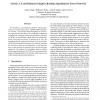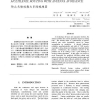SIGCOMM
2000
ACM
14 years 8 months ago
2000
ACM
Current routing protocols are monolithic, specifying the algorithm used to construct forwarding tables, the metric used by the algorithm (generally some form of hop-count), and th...
FPGA
2001
ACM
14 years 8 months ago
2001
ACM
As integrated circuits are migrated to more advanced technologies, it has become clear that crosstalk is an important physical phenomenon that must be taken into account. Crosstal...
ICS
2009
Tsinghua U.
14 years 8 months ago
2009
Tsinghua U.
New static source routing algorithms for High Performance Computing (HPC) are presented in this work. The target parallel architectures are based on the commonly used fattree netw...
SPAA
2003
ACM
14 years 9 months ago
2003
ACM
The increasing application space of interconnection networks now encompasses several applications, such as packet routing and I/O interconnect, where the throughput of a routing a...
SPAA
2003
ACM
14 years 9 months ago
2003
ACM
An ad hoc network is a collection of wireless mobile hosts forming a temporary network without the aid of any fixed infrastructure. Indeed, an important task of an ad hoc network...
ISCA
2003
IEEE
14 years 9 months ago
2003
IEEE
We introduce a load-balanced adaptive routing algorithm for torus networks, GOAL - Globally Oblivious Adaptive Locally - that provides high throughput on adversarial traffic patt...
INFOCOM
2003
IEEE
14 years 9 months ago
2003
IEEE
Abstract— Network throughput and packet delay are two important parameters in the design and the evaluation of routing protocols for ad-hoc networks. While mobility has been show...
IPSN
2004
Springer
14 years 9 months ago
2004
Springer
We study network capacity limits and optimal routing algorithms for regular sensor networks, namely, square and torus grid sensor networks, in both, the static case (no node failu...
MSWIM
2004
ACM
14 years 9 months ago
2004
ACM
Most comparisons of wireless ad hoc routing algorithms involve simulated or indoor trial runs, or outdoor runs with only a small number of nodes, potentially leading to an incorre...
ISPD
2004
ACM
14 years 9 months ago
2004
ACM
As technology advances into nanometer territory, the antenna problem has caused significant impact on routing tools. The antenna effect is a phenomenon of plasmainduced gate oxide...
